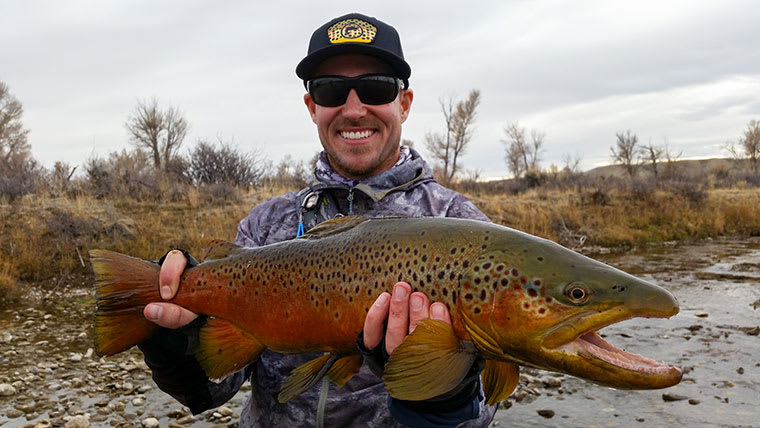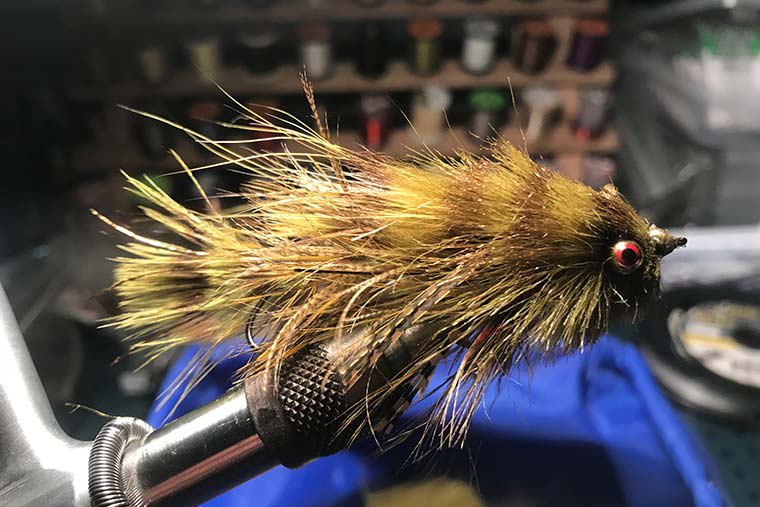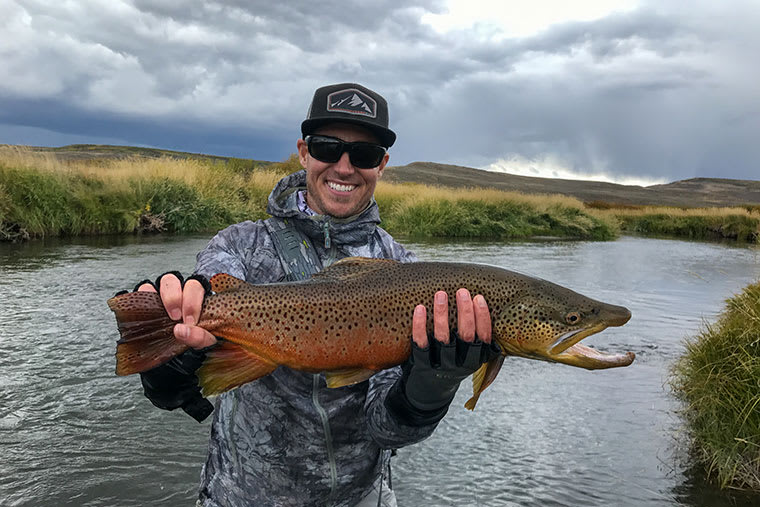How to Catch a Monster Brown on the Fly
Posted by Kris Reynolds on 3rd May 2021
I love Brown Trout. There is something about the physical transformation they go through when become piscivorous and their inclination to murder streamers that has always enchanted me. For some fishermen, catching a brown trout over thirty inches on the fly is the Holy Grail of their fishing careers.
So how do you put yourself in the best position to catch the fish of a lifetime? If you are going to embark on this quest, be prepared for a rollercoaster of emotions. For my own personal journey, I came up just short several times, lived through the winter with a few heartbreaks, spent a small fortune on fly tying materials, logged countless hours on the vise, and sacrificed a couple of relationships along the way. I also caught a lot of big fish and was forced to evolve as a fisherman. Can you get lucky? Yes. But there are also a few things you can do to swing the odds in your favor.

What Kind of Fisherman are You?
Are you a numbers person or are you happy catching one big fish? This is a question you need to ask yourself. Numbers are good and keep the day interesting, but the reality is sometimes the sections of river with the biggest fish have far lower resident fish populations. Like chasing Steelhead or a trophy Musky, if you are not willing to get skunked for a shot at “the one”, you are limiting your opportunities.
Traveling | Paying a Guide
If you’ve got the means, the shortest path to catching the trout of a lifetime is to travel and/or pay a guide. The top tier places to go are the New Zealand backcountry or to Argentina or Chile for sea runs, but you can also find plenty of giant trout in the lower 48. Even if you’re going for a week, having a guide for the first day or two of a trip can help get you oriented in a river you’ve never been to before.
It is important to do your research before booking. Any guide that doesn’t take a deposit is not a pro and should be avoided. Instagram can also be a good research tool when evaluating your prospects. Here are a couple of recommendations in the West that can help put you on a big fish:
Scott Barrus – Scott is the owner of Spinner Fall Guide Service. He’s also one of the longest tenured guides on the Green River below Flaming Gorge Dam in Dutch John, Utah. The Green is famous for world-class dry fly fishing, but what you rarely hear about are some of the truly big fish that lurk within its waters. Shown below is a picture of a 31” Brown that Scott put a client on with a dry fly. He told me he has given a few clients an opportunity at that fish and only one client was able to get it done so far.
Full disclosure, there are thousands of fish per mile in this river. Finding a giant isn’t easy and getting the fly past the smaller ones can add difficulty to the equation. At a minimum, you will have an awesome day with these guys, float a beautiful gin-clear river, and likely catch a bunch of nice fish on large dry flies or streamers. If the stars align and you hit “the day”, you’ll get your chance at a big boy. Nothing wrong with that!
Matt McCannel – Before he ever got Instafamous or featured on Flylords, I met Matt at the Palometa Club while trying to catch a Permit in Mexico. He showed me a picture of one the biggest fly caught brown trout I’ve ever seen taken from a river. He also told me that he tried to put clients on it all season without any luck. After watching everyone fail, he went back at the end of the season and caught it himself. If you’re into spot and stalk fishing for the chance at one big fish, Matt can help you get it done.
The Lodge at Palisades Creek – The Snake River in Idaho is a big, powerful river that holds some absolute monster trout. In the last few years, the guides at the Lodge at Palisades Creek have put clients on some truly large fish including the brown trout shown below and the recently broken Idaho state record Cutthroat. Like the Green, you’ll have to get through some smaller ones or throw streamers all day to get a chance at a monster, but it does happen here.

From left to right: Scott Barrus, Matt McCannel, TLAPC
Places to Look on Your Own
Big River = Big Fish - This seems overly simple, but it really is that easy. Are there small or medium-sized rivers that are hiding monsters? Absolutely, but finding the biggest fish in that system and then getting him to eat can be a harder proposition. You are better off hunting larger rivers, zeroing in on prime spots, and then stalking your quarry. Trout need ample food, good water temps, and places to hide from predators (including people) to grow large. Find the trifecta, and you’ll find “the fish”.
Go Low - Do you know a river that holds big fish, but is also swarmed with people? There are famous rivers all over the West where 95% of the fishermen never venture below the boat ramp where you take out. Why? If you have water quality issues, physical barriers, or landowner problems, I understand. If it’s because the trout population drops from 4,000 per mile to 250, you should consider getting out your streamer rig and covering some water. At worst you might have a tough day of fishing, at best you’ll find a stretch where you can catch a very large brown or 40” pike in the same day.

Lakes - Generally speaking, this is usually a night fishing excursion filled with casting mice or baitfish patterns into the abyss. Does it produce results? Absolutely. I watched my father put more 10 lb+ browns in the freezer in the 80’s than most people will see in a lifetime of fishing.
Above Reservoirs - There are certain times of year that large lake fish will push upstream out of a reservoir to either spawn themselves or gorge on other species’ eggs. Perfect examples would be during landlocked salmon or steelhead runs. If you’ve got fish dumping hormones and eggs into the river system, that lake run behemoth won’t be far behind. In the West, the prevalence of Kokanee Salmon stocking programs has created the perfect recipe to fatten up the brown trout population. In the East, the rivers around the Great Lakes are famous for producing fall-run giants.
Level Up Your Game
Casting in the Wind – Most of the best streamer days I have had are when storm systems are blowing through. If you have trouble casting in the wind, book a saltwater trip or a float trip on the North Platte in Wyoming. A week of getting windblown will expose your casting flaws and humble you. In the long run, it will make you better prepared for when the opportunity presents itself.
Spotting Fish – Learning to spot fish before you spook them is the difference between seeing big fish and catching them. Any time I see something large and fish shaped, I’m looking for the triangle-shaped head, pectoral fins, and even the slightest tail movement. Slow down your pace and movements in these situations. Sometimes that torpedo in the river that couldn’t possibly be a fish because it’s too big, is actually a fish, and this is your chance.
Reading Water – This is one of the biggest differences I see between skilled and non-threatening fishermen (NTFs). The skilled fisherman will not waste time on garbage water, and the NTF will spend at least half an hour on it. Having a good understanding of current, ambush points, and where food stacks up are key elements to figuring out where the fish will be.
Stealth – Learning to be stealthy is critical when you find that big fish. It comes down to how you dress, how you move, how you walk in the water, line angles, and your fly presentation. Stealth is situational, so I’m not going to tell you how to do these things, but you should think about all of them when you’re on the hunt. If you’re the guy in the bright white shirt or orange puffy jacket stomping up the middle of the river all day, it might be time for an intervention.
Tying Flies – Tying flies is both time consuming and expensive. It is also a huge advantage for catching more and larger fish. Being able to recognize what is happening in the river and replicate it on the vise is the recipe for success when things get tough. The other benefits are that the fish in pressured rivers are not used to seeing your patterns, your flies last longer, and you significantly lower your risk of losing a brute due to cheap hooks.

Expand Your Horizons – Specializing in catching trout will get you far, but there is a lot to learn from chasing other species:
- Go catch a big musky, carp, bonefish, or anything else that makes you feel completely outgunned on an 8 weight. Understanding rod angles and how to keep them pinned on a barbless hook is critical when fighting big fish. Avoid lifting your rod straight vertical at all costs!
- Learn how to double haul and shoot the fly accurately - This is another skill that separates skilled fishermen from NTFs. I learned this one from getting humbled on the front of a panga while chasing Permit, and I think it applies to fishing streamers out of a boat. If you’re able to shoot the fly on target in two false casts or less, your line will be in the water twice as much if you’re taking four or five every cast. More time in the water equals more opportunities for hookups. No shadow casting!
- Learn how to cast big flies – Chasing pike or muskies will get you ready to cast larger flies to pretty much any predatory species in the world, and big browns are apex predators. You do not need to throw huge flies to catch big butter dragons, but you’ll want to be able to throw up to 7” flies without hesitation. This skill is also immensely valuable if you ever want to go somewhere to chase a GT.
Gear
Rods – When most people start fly fishing, they typically buy a 4 or 5 weight rod. These are fine for small stream fishing or handling dinks, but these rod sizes lack the backbone to land larger fish quickly and release them. They are also too flimsy to effectively throw any meat. In my opinion, the best and most versatile rod for chasing large trout is a quality 6 weight with a fighting butt. It can handle nymph rigs or smaller dries, but still has the strength to punch big dries or streamers through the wind. When throwing larger streamers or using any kind of sinking line, I typically use an 8 weight. If I am fishing out of a boat, I typically rig both setups to handle different types of water. Recommendations: Sage X, G Loomis NRX, Orvis Helios
Reels – I always love it when I hear someone say, “You don’t need a drag for trout fishing.” That is usually a clear indicator that they need to go catch bigger fish. Having a reel with a good, smooth drag is critical for keeping the fish hooked and landing it quickly, especially in faster water. Recommendations: Orvis Hydros, Lamson Force SL, Nautilus X-Series
Fly Line – Aside from the fly itself, your fly line is your next most important piece of equipment. There are lots of opinions out there, but from my perspective, the Scientific Anglers Amplitude Smooth Infinity is hands-down the best trout fly line I have ever fished. The coating, slickness, and durability of the SA Amplitude series lines are worth every penny.

Leaders and Tippet – My main recommendation here is, use as heavy tippet as you can get away with. A lot of people buy into fish being extremely tippet shy, but I’ve only experienced that a handful of times in my life. I want to be able to put as much pressure on the fish as I can to land him quickly and release him.
For dries and nymph rigs, I typically only use nylon tippet for trout fishing. I’ve fished both Scientific Anglers and Rio tippet, and have had success with both, but primarily fish SA Absolute Trout Stealth right now. For big dries, I typically fish 2-3x to keep them from twisting up my line in the wind. For smaller flies, I rarely use anything below 4x.
For streamers, I build my own leader with about 3 ft of 25lb and 2-3 ft of 0X fluorocarbon with a size large No-Knot Fas-Snap fly clip at the end. Using the clip saves you from wasting tippet and makes switching your streamer fast and easy throughout the day. When buying clips, find ones that are rated over 20 pounds and shy away from the bright silver ones. I usually look for the ones made for bass fishing versus the thinner ones made for flies. Black or bronze colors work best.
Flies – Your fly is the most important part of your setup. If the fish won’t eat your fly, then none of your other gear matters. The key point here is to make sure your fly has a good hook and won’t fall apart after landing one fish. If I have to buy flies, I will always brush the threads and key points of the fly with a little Zap-a-Gap to keep it from falling apart. This will save you lots of money on foam hoppers if done correctly.
Net – For conservation purposes, I only use nets with rubberized mesh. My recommendation here is to find one that strikes a balance between being large enough to scoop a big boy, and not being so big that it is cumbersome to carry all day (or night).
Net Guy – Your fishing partner is as important as any piece of gear. If you’re fishing with a buddy, make sure he’s a pro on the net. Good communication is key when battling a big fish. Don’t try to scoop the fish when he’s too green or you don’t have a good shot at getting the whole fish. There is nothing more heartbreaking than watching the biggest fish of your life spit the hook and roll out of the net on a bad net attempt.

About Us
Campman is an outdoor retail store located in Salt Lake City, Utah that specializes in gear and equipment for camping, skiing, backpacking, climbing, and everything in between. We understand that the difference between a bad memory and the adventure of a lifetime can come down to the gear you take with you when you head outdoors, and we want our customers to have the best experiences possible. When it comes to getting outside, we get it, and we’ll get you the gear you need to get there.
Questions? Feel free to contact us by phone at (801) 999-8117 or by email at sales@campman.com.
Share on:

